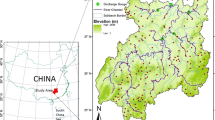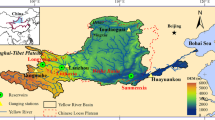Abstract
Global gridded precipitation is an essential driving input for hydrologic models to simulate runoff dynamics in large river basins. However, the data often fail to adequately represent precipitation variability in mountainous regions due to orographic effects and sparse and highly uncertain gauge data. Water balance simulations in tropical montane regions covered by cloud forests are especially challenging because of the additional water input from cloud water interception. The ISI-MIP2 hydrologic model ensemble encountered these problems for Andean sub-basins of the Upper Amazon Basin, where all models significantly underestimated observed runoff. In this paper, we propose simple yet plausible ways to adjust global precipitation data provided by WFDEI, the WATCH Forcing Data methodology applied to ERA-Interim reanalysis, for tropical montane watersheds. The modifications were based on plausible reasoning and freely available tropics-wide data: (i) a high-resolution climatology of the Tropical Rainfall Measuring Mission (TRMM) and (ii) the percentage of tropical montane cloud forest cover. Using the modified precipitation data, runoff predictions significantly improved for all hydrologic models considered. The precipitation adjustment methods presented here have the potential to enhance other global precipitation products for hydrologic model applications in the Upper Amazon Basin as well as in other tropical montane watersheds.




Similar content being viewed by others
References
Arnold JG, Srinivasan R, Muttiah R, Williams J (1998) Large area hydrologic modeling and assessment part I: model development. J Am Water Resour Assoc 34:73–89
Bergström S (1995) The HBV model. In: Singh VP (ed) Computer models of watershed hydrology. Water Resources Publications, Highlands Ranch, CO., pp. 443–476
Betts AK, Ball JH, Viterbo P, Dai A, Marengo J (2005) Hydrometeorology of the Amazon in ERA-40. J Hydrometeorol 6(5):764–774. doi:10.1175/JHM441.1
Betts AK, Köhler M, Zhang Y (2009) Comparison of river basin hydrometeorology in ERA-Interim and ERA-40 reanalyses with observations. J Geophys Res-Atmos 114(D2). doi:10.1029/2008JD010761
Blacutt LA, Herdies DL, de Gonçalves LGG, Vila DA, Andrade M (2015) Precipitation comparison for the CFSR, MERRA, TRMM3B42 and combined scheme datasets in Bolivia. Atmos Res 163:117–131. doi:10.1016/j.atmosres.2015.02.002
Bookhagen B, Strecker MR (2008) Orographic barriers, high-resolution TRMM rainfall, and relief variations along the eastern Andes. Geophys Res Lett 35(6):L06403. doi:10.1029/2007GL032011
Bruijnzeel LA, Mulligan M, Scatena FN (2011) Hydrometeorology of tropical montane cloud forests: emerging patterns. Hydrol Process 25(3):465–498. doi:10.1002/hyp.7974
Buytaert W, Celleri R, Willems P, Bièvre BD, Wyseure G (2006a) Spatial and temporal rainfall variability in mountainous areas: a case study from the south Ecuadorian Andes. J Hydrol 329(3–4):413–421. doi:10.1016/j.jhydrol.2006.02.031
Buytaert, W. et al., 2006b. Analysis of the Water Balance of Small Páramo Catchments in South Ecuador. In: Krecek, J., Haigh, M. (Eds.), Environmental Role of Wetlands in Headwaters. NATO Science Series: IV: Earth and Environmental Sciences. Springer Netherlands, pp. 271–281. doi:10.1007/1-4020-4228-0_24
Campling P, Gobin A, Beven K, Feyen J (2002) Rainfall-runoff modelling of a humid tropical catchment: the TOPMODEL approach. Hydrol Process 16(2):231–253. doi:10.1002/hyp.341
Carvalho LMV, Jones C, Liebmann B (2004) The South Atlantic Convergence Zone: Intensity, Form, Persistence, and Relationships with Intraseasonal to Interannual Activity and Extreme Rainfall. J Clim 17(1):88–108. doi:10.1175/1520-0442(2004)017 < 0088:TSACZI > 2.0.CO;2
Célleri R, Feyen J (2009) The hydrology of tropical Andean ecosystems: importance, knowledge status, and perspectives. Mt Res Dev 29(4):350–355. doi:10.1659/mrd.00007
Clark KE et al. (2014) The hydrological regime of a forested tropical Andean catchment. Hydrol Earth Syst Sci 18(12):5377–5397. doi:10.5194/hess-18-5377-2014
Coe MT, Costa MH, Botta A, Birkett C (2002) Long-term simulations of discharge and floods in the Amazon Basin. J Geophys Res: Atmos 107(D20):LBA 11-1–LBA 11-17. doi:10.1029/2001JD000740
Decharme B, Douville H (2006) Uncertainties in the GSWP-2 precipitation forcing and their impacts on regional and global hydrological simulations. Clim Dyn 27(7–8):695–713. doi:10.1007/s00382-006-0160-6
Espinoza Villar JC et al. (2009) Spatio-temporal rainfall variability in the Amazon basin countries (Brazil, Peru, Bolivia, Colombia, and Ecuador). Int J Climatol 29(11):1574–1594. doi:10.1002/joc.1791
Eva HD et al. (2004) A land cover map of South America. Glob Chang Biol 10(5):731–744. doi:10.1111/j.1529-8817.2003.00774.x
Filizola N, Guyot JL (2004) The use of Doppler technology for suspended sediment discharge determination in the river Amazon / L’utilisation des techniques Doppler pour la détermination du transport solide de l’Amazone. Hydrol Sci J 49(1):143–153. doi:10.1623/hysj.49.1.143.53990
Filizola N, Guyot JL, Guimarães V (2009) Measuring the discharge of the Amazon River using Doppler technology (Manacapuru, Amazonas, Brazil). Hydrol Process 23(22):3151–3156. doi:10.1002/hyp.7385
Giambelluca T, Gerold G (2011) Hydrology and biogeochemistry of tropical montane cloud forests. In: Levia DF, Carlyle-Moses D, Tanaka T (eds) Forest hydrology and biogeochemistry. Ecological Studies, Springer Netherlands, pp. 221–259. doi:10.1007/978-94-007-1363-5_11
Guimberteau M et al. (2012) Discharge simulation in the sub-basins of the Amazon using ORCHIDEE forced by new datasets. Hydrol Earth Syst Sci 16(3):911–935. doi:10.5194/hess-16-911-2012
Hall, A., 2004. Spatial patterns in catchment hydrology—observations and modelling. Roger Grayson and Gunter Blöschl (eds). Cambridge University Press, 423 pp, 2000, ISBN 0-521-63316-8. Hydrol Process, 18(2): 393–394. doi:10.1002/hyp.5215
Houze RA (2012) Orographic effects on precipitating clouds. Rev Geophys 50(1):RG1001. doi:10.1029/2011RG000365
Krysanova V, Müller-Wohlfeil D-I, Becker A (1998) Development and test of a spatially distributed hydrological/water quality model for mesoscale watersheds. Ecol Model 106(2–3):261–289. doi:10.1016/S0304-3800(97)00204-4
Kumar R, Samaniego L, Attinger S (2013) Implications of distributed hydrologic model parameterization on water fluxes at multiple scales and locations. Water Resour Res 49(1):360–379. doi:10.1029/2012WR012195
Meybeck M, Green P, Vörösmarty C (2001) A New Typology for Mountains and Other Relief Classes. Mt Res Dev 21(1):34–45. doi:10.1659/0276-4741(2001)021[0034:ANTFMA]2.0.CO;2
Monteiro JAF, Strauch M, Srinivasan R, Abbaspour K, Gücker B (2015) Accuracy of grid precipitation data for Brazil: application in river discharge modelling of the Tocantins catchment. Hydrological Processes. doi:10.1002/hyp.10708
Mu Q, Zhao M, Running S (2013) MODIS global terrestrial evapotranspiration (ET) product (NASA MOD16A2/A3), algorithm theoretical basis document, collection 5. Numerical Terradynamic Simulation Group, University of Montana, Missoula, MT, USA, NASA HQ
Mulligan M (2010) Modelling the tropics-wide extent and distribution of cloud forests and cloud forest loss with implications for their conservation priority. In: Hamilton LS (ed) Tropical montane cloud forests. International hydrology series. Cambridge University Press, Cambridge and New York, pp. 14–38
Mulligan M, Burke SM (2005) DFID-FRP project R7991, FIESTA: fog interception for the enhancement of streamflow in tropical areas, final technical report of AMBIOTEK/ King’s College London contributions. Department for International Development, London
Nerini D et al. (2015) A comparative analysis of TRMM–rain gauge data merging techniques at the daily time scale for distributed rainfall–runoff modeling applications. J Hydrometeorol 16(5):2153–2168. doi:10.1175/JHM-D-14-0197.1
Nesbitt SW, Anders AM (2009) Very high resolution precipitation climatologies from the tropical rainfall measuring mission precipitation radar. Geophys Res Lett 36(15):L15815. doi:10.1029/2009GL038026
Rienecker MM et al. (2011) MERRA: NASA’s modern-era retrospective analysis for research and applications. J Clim 24(14):3624–3648. doi:10.1175/JCLI-D-11-00015.1
Saha S et al. (2013) The NCEP climate forecast system version 2. J Clim 27(6):2185–2208. doi:10.1175/JCLI-D-12-00823.1
Samaniego L, Kumar R, Attinger S (2010) Multiscale parameter regionalization of a grid-based hydrologic model at the mesoscale. Water Resour Res 46(5):W05523. doi:10.1029/2008WR007327
Scheel MLM et al. (2011) Evaluation of TRMM multi-satellite precipitation analysis (TMPA) performance in the Central Andes region and its dependency on spatial and temporal resolution. Hydrol Earth Syst Sci 15(8):2649–2663. doi:10.5194/hess-15-2649-2011
Sheffield J, Goteti G, Wood EF (2006) Development of a 50-year high-resolution global dataset of meteorological Forcings for land surface modeling. J Clim 19(13):3088–3111. doi:10.1175/JCLI3790.1
Strauch M, Volk M (2013) SWAT plant growth modification for improved modeling of perennial vegetation in the tropics. Ecol Model 269:98–112. doi:10.1016/j.ecolmodel.2013.08.013
Tian Y, Peters-Lidard CD (2010) A global map of uncertainties in satellite-based precipitation measurements. Geophys Res Lett 37(24):L24407. doi:10.1029/2010GL046008
Uppala SM et al. (2005) The ERA-40 re-analysis. Q J R Meteorol Soc 131(612):2961–3012. doi:10.1256/qj.04.176
Verzano, K., (2009). Climate change impacts on flood related hydrological processes: Further development and application of a global scale hydrological model. PhD Thesis, University of Kassel, Kassel.
Ward E, Buytaert W, Peaver L, Wheater H (2011) Evaluation of precipitation products over complex mountainous terrain: a water resources perspective. Adv Water Resour 34(10):1222–1231. doi:10.1016/j.advwatres.2011.05.007
Weedon GP et al. (2011) Creation of the WATCH forcing data and its use to assess global and regional reference crop evaporation over land during the twentieth century. J Hydrometeorol 12(5):823–848. doi:10.1175/2011JHM1369.1
Weedon GP et al. (2014) The WFDEI meteorological forcing data set: WATCH forcing data methodology applied to ERA-interim reanalysis data. Water Resour Res 50(9):7505–7514. doi:10.1002/2014WR015638
Zubieta R, Getirana A, Espinoza JC, Lavado W (2015) Impacts of satellite-based precipitation datasets on rainfall–runoff modeling of the western Amazon basin of Peru and Ecuador. J Hydrol 528:599–612. doi:10.1016/j.jhydrol.2015.06.064
Zulkafli Z, Buytaert W, Onof C, Lavado W, Guyot JL (2013) A critical assessment of the JULES land surface model hydrology for humid tropical environments. Hydrol Earth Syst Sci 17(3):1113–1132. doi:10.5194/hess-17-1113-2013
Zulkafli Z et al. (2014) A comparative performance analysis of TRMM 3B42 (TMPA) versions 6 and 7 for hydrological applications over Andean–Amazon River basins. J Hydrometeorol 15(2):581–592. doi:10.1175/JHM-D-13-094.1
Acknowledgments
We would like to thank Stephan Thober for his mathematical support in developing the TRMM normalization scheme as well as Valentina Krysanova and Fred Hattermann for coordinating the regional water sector within ISI-MIP2.
Author information
Authors and Affiliations
Corresponding author
Additional information
This article is part of a Special Issue on “Hydrological Model Intercomparison for Climate Impact Assessment” edited by Valentina Krysanova and Fred Hattermann.
Electronic Supplementary Material
ESM 1
(DOCX 67660 kb)
Rights and permissions
About this article
Cite this article
Strauch, M., Kumar, R., Eisner, S. et al. Adjustment of global precipitation data for enhanced hydrologic modeling of tropical Andean watersheds. Climatic Change 141, 547–560 (2017). https://doi.org/10.1007/s10584-016-1706-1
Received:
Accepted:
Published:
Issue Date:
DOI: https://doi.org/10.1007/s10584-016-1706-1




